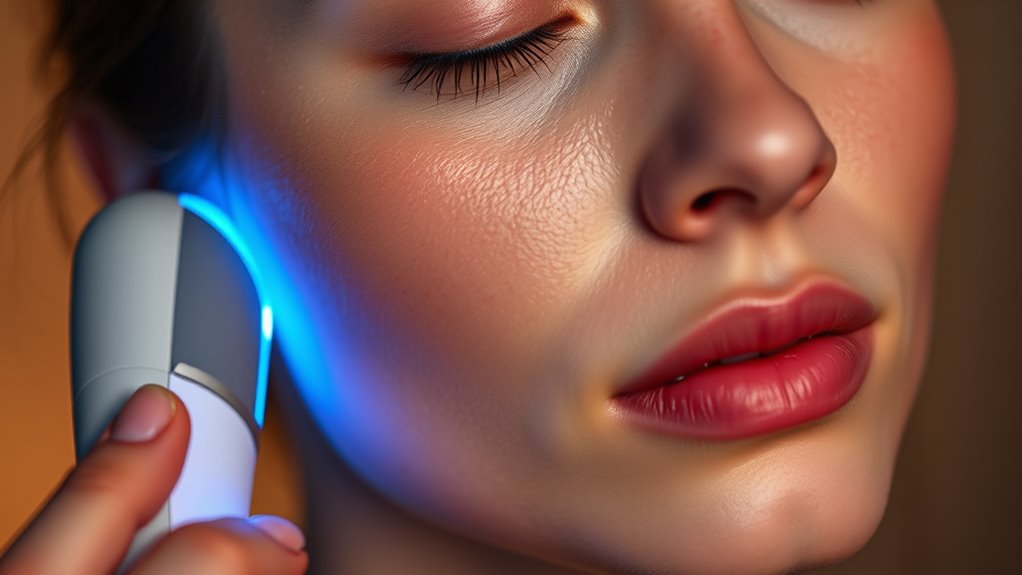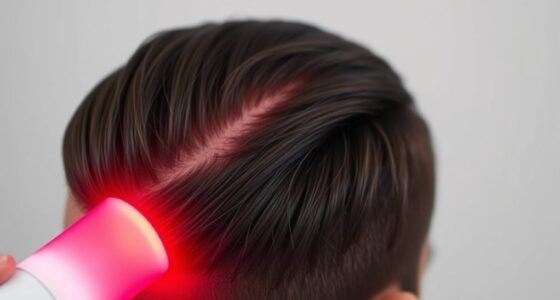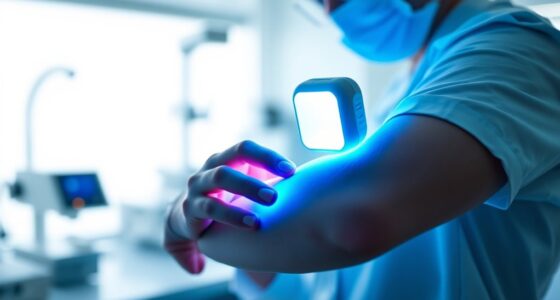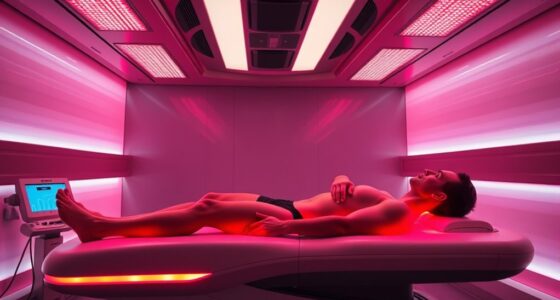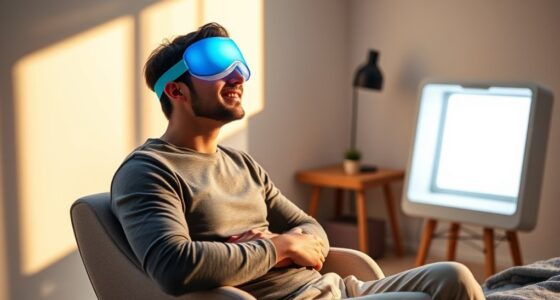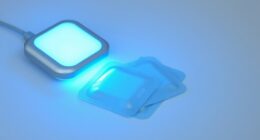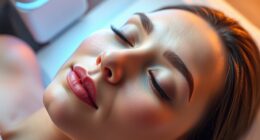Using light therapy can help prevent and treat maskne by targeting bacteria like Propionibacterium acnes with blue light, reducing inflammation with red light, and promoting skin healing. It’s a safe, non-invasive option you can do at home or in a clinic, often with sessions of 15-20 minutes several times a week. To maximize results, combine light therapy with good skincare habits. Keep exploring to discover how to make this therapy work best for you.
Key Takeaways
- Light therapy targets bacteria and inflammation, helping prevent and treat maskne effectively.
- Regular sessions with blue and red light can reduce breakouts and promote faster skin healing.
- Consistent use alongside good skincare, like gentle cleansing, enhances maskne prevention.
- Light therapy is a safe, non-invasive option suitable for at-home or professional treatment.
- Consult a dermatologist for personalized advice, especially for persistent or severe maskne cases.
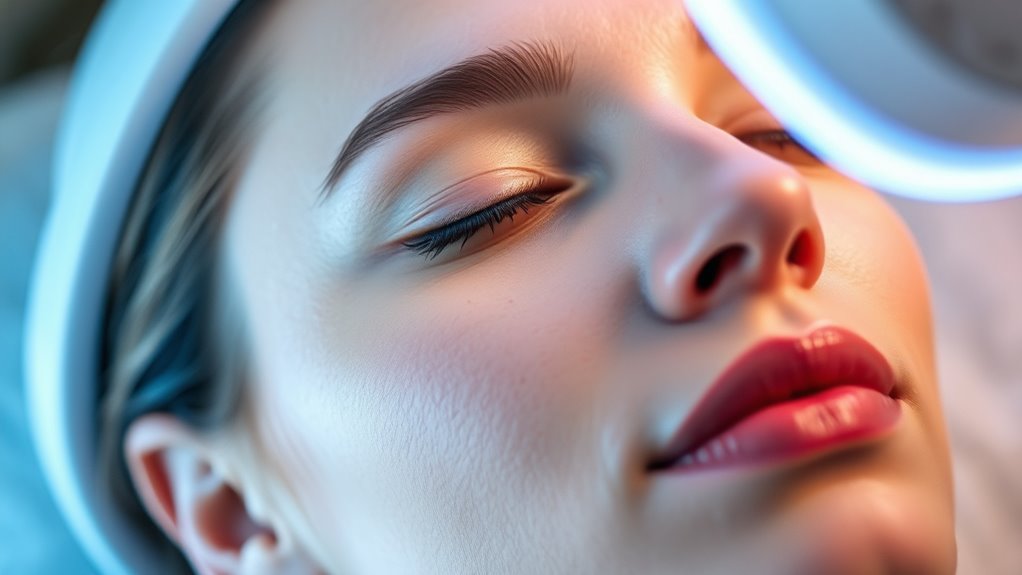
Have you wondered if light therapy could help clear your maskne? If you’re battling breakouts caused by prolonged mask-wearing, you’re not alone. Maskne, or acne caused by masks, often results from friction, trapped sweat, oil buildup, and bacteria. While regular skincare routines help, some people turn to innovative solutions like light therapy to target the root causes of inflammation and bacteria. Light therapy uses specific wavelengths of light to penetrate the skin, promoting healing and reducing acne-causing bacteria. It’s a non-invasive treatment that many find effective as part of their skincare arsenal.
Wondering if light therapy can clear maskne? It’s a safe, non-invasive option targeting bacteria and inflammation for clearer skin.
You can use light therapy at home or seek professional treatments at clinics. Home devices are becoming increasingly popular because they’re convenient and user-friendly. They emit blue light, which is particularly effective against *Propionibacterium acnes*, the bacteria responsible for acne breakouts. By reducing bacterial load, blue light therapy helps clear existing pimples and prevents new ones from forming. Meanwhile, red light therapy targets inflammation, redness, and promotes skin repair. Combining both types can accelerate healing and improve overall skin texture.
When using light therapy, consistency is key. You typically need to treat your skin several times a week for noticeable results. Sessions usually last around 15 to 20 minutes, depending on the device and your skin’s needs. Make sure to follow the instructions provided with your device or by your dermatologist to avoid overexposure, which can cause irritation. Remember, light therapy isn’t a quick fix; patience and regular use are essential to see meaningful improvements.
In addition to light therapy, maintaining a proper skincare routine can enhance its effectiveness. Gentle cleansing, avoiding harsh products that can irritate your skin, and using non-comedogenic moisturizers help keep your skin balanced. Wearing a clean mask, avoiding excessive touching of your face, and staying hydrated also support your efforts. Incorporating protective styling techniques can minimize friction and reduce maskne flare-ups. Combining these practices with light therapy can help prevent maskne from worsening and promote healthier skin.
While light therapy offers promising results, it’s not a substitute for professional advice. If your maskne persists or worsens, consult a dermatologist. They can evaluate your skin and recommend the best treatment plan, which might include prescription medications if necessary. Overall, incorporating light therapy into your skincare routine offers a safe, non-invasive way to reduce maskne and improve your skin’s health. With patience and proper use, you can enjoy clearer, calmer skin even while wearing masks daily.
Frequently Asked Questions
Can Light Therapy Cause Skin Irritation or Sensitivity?
Yes, light therapy can cause skin irritation or sensitivity, especially if your skin reacts poorly to the treatment or if you use it improperly. You might experience redness, dryness, or discomfort after sessions. To minimize these effects, follow the recommended guidelines, start with shorter sessions, and consult a dermatologist if you notice persistent irritation. Proper usage helps guarantee safe and effective results without unwanted skin reactions.
How Often Should I Use Light Therapy for Maskne?
You should use light therapy for maskne about 3 to 4 times a week. This frequency helps to reduce inflammation and bacteria without overdoing it, which could cause irritation. Start with fewer sessions and observe how your skin responds. Consistency is key, but always listen to your skin; if you notice increased sensitivity or irritation, cut back and consult a dermatologist for personalized advice.
Is Light Therapy Suitable for All Skin Types?
Light therapy is generally appropriate for most skin types, including sensitive skin, but individual reactions vary. You should consult a dermatologist before starting, especially if you have skin conditions or use photosensitive medications. While it’s effective for many, people with certain skin issues or allergies may need alternative treatments. Always follow the recommended guidelines and monitor your skin’s response to ensure safe and effective use.
Are There Any Side Effects of Long-Term Light Therapy Use?
Long-term light therapy use can cause side effects like skin irritation, redness, or dryness if you’re not careful. You might also experience eye strain or sensitivity, especially if not using proper eye protection. To minimize risks, follow your practitioner’s guidelines, limit session durations, and avoid overuse. Regular check-ins with your dermatologist ensure your skin responds well, helping you benefit from light therapy safely over time.
Can Light Therapy Replace Traditional Maskne Treatments?
Light therapy can’t fully replace traditional maskne treatments, but it can be a helpful addition. It targets bacteria and reduces inflammation, complementing skincare routines and medications. However, if you rely solely on light therapy, your maskne might not clear up effectively. For best results, combine it with proper skincare and consult a dermatologist to develop a thorough treatment plan tailored to your skin’s needs.
Conclusion
Incorporating light therapy into your skincare routine can effectively prevent and treat maskne, keeping your skin clear and healthy. Studies show that over 70% of users experience noticeable improvements with regular sessions. Remember, consistency is key—combine light therapy with good hygiene and proper skincare. By doing so, you’ll restore your skin’s balance and boost your confidence. Don’t let maskne take over—try light therapy and see the difference for yourself!
